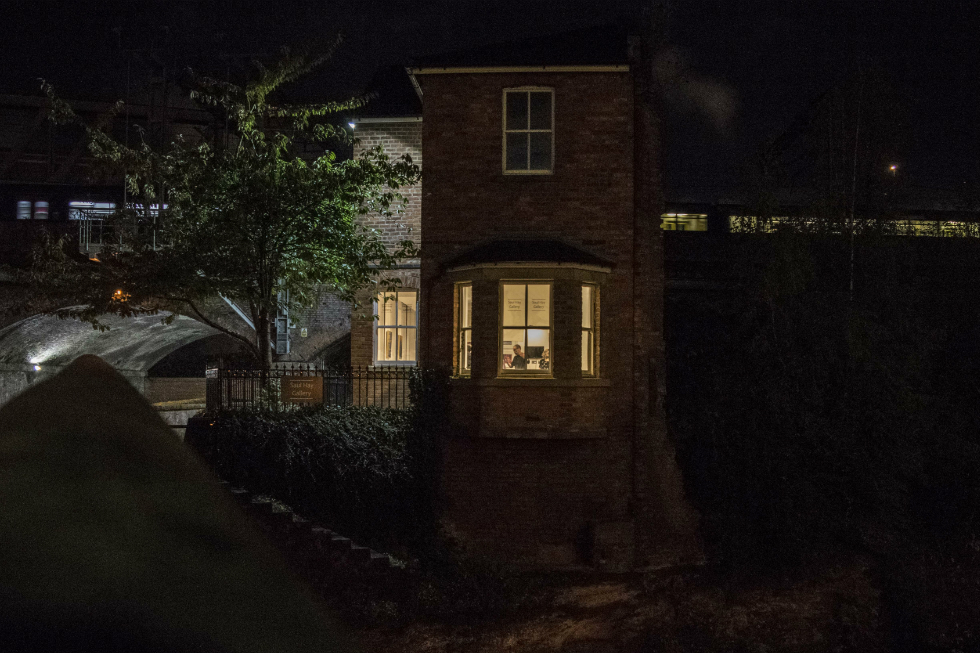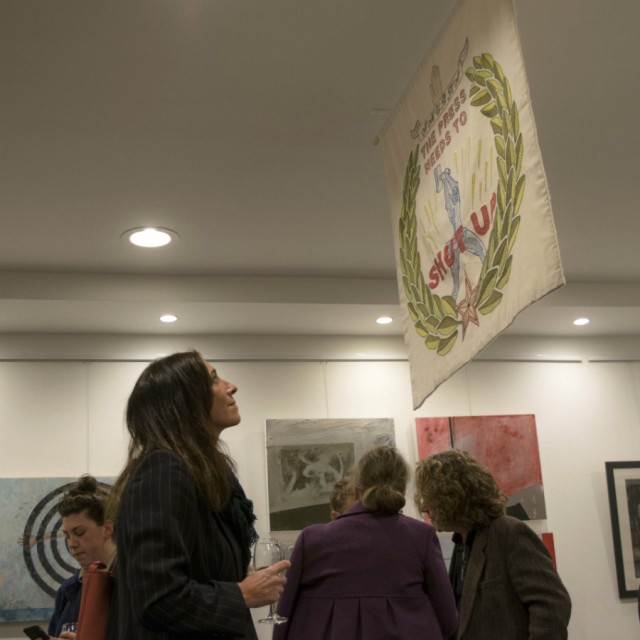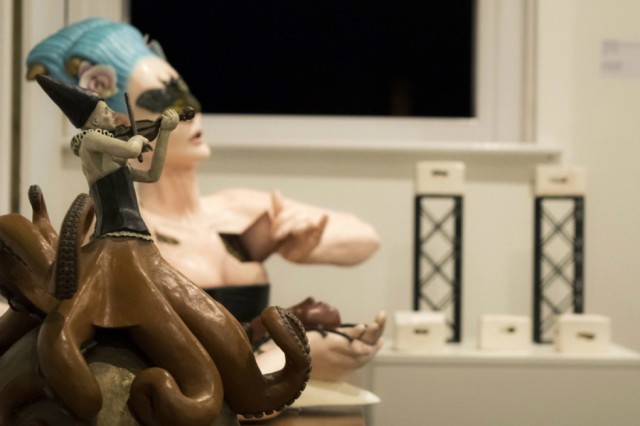Reviewed: Room 103 – A Tribute To George Orwell

In this group exhibition inspired by George Orwell’s always-relevant novel of dystopia, Joe Fenn finds artworks that prick our greatest fears, while warning against complacency…
Given the extensive liberties and luxuries likely available to readers of this article, it might be an objectionable, perhaps even offensive exaggeration to describe the modern Western society in which we live as dystopian. But it is true to say that our current popular culture is going through something of an age of dystopia; confirming such terrible futures are very much on our minds. Over the past few years, the genre has rocketed up bestseller lists and viewings tables, carried by a host of political and social concerns and carrying these concerns with it to prominence in the mainstream dialogue. Many of us clearly have grave concerns for our future.
It is these concerns which are the seed of Room 103, a thoughtful and thought-provoking new show in Manchester’s Saul Hay Gallery. In this arena, there is one author whose vision has imprinted itself most lastingly on the public imagination, shaping myriad later visions, and lending his name to a unique adjective synonymous with the word. In his seminal Nineteen Eighty-Four, George Orwell (1949) painted a vision of the world coloured by themes which resonate just as strongly today as they did in his. Room 103 is a collection of responses to these themes, along with many others found in Orwell’s work, by a diverse group of seventeen international artists.
Such serious subjects as totalitarianism, war, class, and propaganda, however, are not at the forefront of the mind as one approaches Saul Hay. From the outside, the quaint, cottage-like building hardly brings to mind brainwashing centres buried deep in the enigmatic headquarters of ruthless totalitarian oligarchies. Indeed, the structure seems almost too pleasant even for the characterful old industrial area of Castlefield in which it is tucked away. A world away from urban dystopia, Saul Hay is reminiscent of idyllic English countryside, as though airlifted straight from the grounds of a Cheshire manor house and shoe-horned in between the redbrick railway bridges and industrial canals.
But such pleasant images are quickly swept away upon entering the gallery. Stepping through the doorway one immediately comes up against a large, haggard face looking out from a canvas; a blown-up book cover design for Orwell’s study in social class, The Road to Wigan Pier (1937). Under these watching eyes one walks through the corridor and out into a bright, calm gallery space filled with macabre expressions of personal, public, and political angst. Canvasses on the wall portray naked individuals trapped against stone walls by cross-hairs; Soviet Union-esque propaganda hangs from the ceiling; and along the far wall stand unsettling sculptures of distorted human figures, all creating a tense, unusual atmosphere in what one feels should ordinarily be a perfectly relaxing space.
While these works and all others in the exhibition are centred around Orwell, Room 103 did not, in fact, grow directly from his work. Rather, the show grew from artists finding themselves drawn to those same subjects which have become so prominent in our popular culture. British painter and artist Glenn Ibbitson, progenitor of Room 103, recognised the overlap between his own work and Orwell’s as, over a number of years, he pulled at the thematic threads of his art and found they often turned out to be of the same fabric woven through Orwell’s writing. As Ibbitson’s awareness of this connection grew, conversations with other artists revealed that many had the same experience, often finding themselves compared to Orwell without having consciously approached his writing in their art. Just as dystopia has seeped up through our popular culture, so too did these artists find their own work laced with dystopian visions. It is testament to the breadth and lucidity of Orwell’s writing that these artists found that so much of the author’s work had influenced various elements of their own.

From these realisations, Room 103 was born, initially as an online forum for artists to share work influenced by and overlapping with Orwell. It was when Ibbitson met Ian Hay, founder and director of Saul Hay Gallery, that Room 103 became a physical space. It was some time since it had last been so; the name is taken, as is Room 101, from the layout of the original BBC broadcasting house. The original Room 101 was the room from which Orwell sent out his wartime correspondence. Room 103, just next door, sent out broadcasts relating to the arts.
Of the pieces in this new realisation of Room 103, Ibbitson’s own work provides some of the starkest examinations of the darkest and most truly Orwellian themes. His two paintings, Target: Dark Room and Target: Pinned to Wall, portray graphically realistic human figures trapped by great circular targets, as though caught in a searchlight or facing a firing squad. Ibbitson portrays the naked and defenceless human individual caught in the violent gaze of some much greater power. One is inevitably reminded of Winston Smith, immobile in the basement of the Ministry of Love.
American textile artist Mary Mazziotti explores closely related themes through Needling the Regime, a series of propaganda tapestries for her imagined country of Amurka which hang from the ceiling of Saul Hay. In Mazziotti’s work Soviet imagery and lettering play against the American ideologies which are her target, while the painstaking nature of the medium of needlework clash with the crass, offhanded slogans of “the press needs to shut up” and “just don’t worry about it”. The juxtapositions and contradictions running through her work inspire uncomfortable reflection on her themes, the effect being that we are forced to consider how susceptible we are to accepting outrageous, inconsistent, even impossible propositions if presented to us through rousing propaganda or conveyed by a confident and convincing politician in a sharp suit. The slogan on the workers’ caps – “Make Amurka Great Again” – leave little room for doubt about the true target of her work.
While Nineteen Eighty-Four may dominate Room 103, many of Orwell’s other works also feature in the artists’ pieces. Several explore the theme of war through responses to Homage to Catalonia, Orwell’s memoir of fighting in the Spanish civil war. The subject is arguably as relevant to current times as Orwell’s, given the dramatic ongoing independence struggles in the region which have flared up recently in such ugly fashion. Images from Tony Baker’s book Homage to Homage to Catalonia adorn one wall, comparing and contrasting Orwell’s Catalonia with the aftermath of the 2017 independence referendum, while Sonia Boué uses poetry and painting to explore the work of the little-known British artist and activist Felicia Browne. An almost exact contemporary of Orwell’s, Browne too found herself in Barcelona when the civil war broke out. While Orwell fought in the war and just about survived when shot through the neck, Browne became the first Briton to die in the conflict when, running to the aid of a fallen fighter, she was shot and killed. Boué’s work speaks to the callous indifference of war; for the sake of a few seconds or inches, it may instead have been Orwell who perished, and Browne who became a figurehead of British culture and history.

Other pieces tackle various other of Orwell’s themes, from class to language to industry and modernity. However, it is those pieces which are most difficult to understand which capture most accurately the lasting allure of Orwell’s most famous work, and dystopian fiction more generally. Clare Ferguson-Walker’s strange and unnerving sculptures – her tentacled violinists, clockwork hearts, and faceless horror – do not yield easily to interpretation, nor to comparisons with Orwell. They are more a representation of a personal angst to which Orwell’s work has spoken in some private and unknowable fashion. And it is these self-created and self-inflicted horrors that draw us to dystopian fiction. The worlds created by authors such as Orwell are not sincere predictions for the future; rather, they are grotesque caricatures of the world in which they live, built on their creators’ fears. Their true power is in providing us ground on which we can then run wild. Just as in horror it is often that which never appears on camera which scares us most, the power here lies in exciting our own paranoias, justifying our own fears and giving us the tools to craft our own private worst-case scenarios.
It is also this ability to provoke thought which makes our dystopian nightmares so important, even in times of peace and freedom, and makes artistic expressions such as Room 103 essential to wider political participation. Life, in the modern West at least, is as good as it has perhaps ever been, and our political and social freedoms extend further than they have for the majority of humanity which has gone before us. Yet it would be unwise to take this for granted. As Orwell was so keenly aware, totalitarian oppression does not arrive fully formed; it creeps upon a society, all smiles and soothing soundbites, until it encircles it on all sides. Only through constant vigilance can we ensure we retain our freedoms. Being exposed to a range of artists’ worst fears and conceptions of the darkest kinds of political oppression is one way to ensure we remain vigilant enough to protect our most important freedoms.
Joe Fenn
Room 103 – a tribute to George Orwell continues at Saul Hay Gallery, Manchester, until 11 November 2018
Images courtesy John James Lynch





